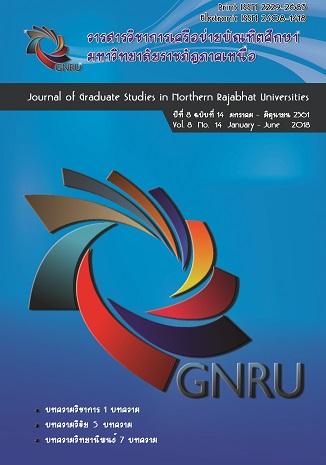ความสัมพันธ์เชิงสาเหตุระหว่างภาวะผู้ประกอบการและการมุ่งเน้นการตลาดที่ส่งผลต่อความได้เปรียบในการแข่งขันของธุรกิจโรงแรมขนาดเล็ก จังหวัดเชียงใหม่; The Causal Relationship Model Between Entrepreneurship and Marketing Orientation effecting the Competitive Adva
Main Article Content
Abstract
การวิจัยนี้มีวัตถุประสงค์เพื่อศึกษาความสัมพันธ์เชิงสาเหตุระหว่างภาวะผู้ประกอบการ การมุ่งเน้นการตลาดที่ส่งผลต่อความได้เปรียบในการแข่งขันของธุรกิจโรงแรมขนาดเล็ก จังหวัดเชียงใหม่ เป็นการวิจัยเชิงปริมาณ โดยทำการเก็บรวบรวมข้อมูลด้วยแบบสอบถามไปยังผู้ประกอบการธุรกิจโรงแรมขนาดเล็ก จังหวัดเชียงใหม่ ได้รับกลับคืนมาจำนวน 286 ชุด โดยใช้สถิติพรรณนาวิเคราะห์ค่าเฉลี่ยและส่วนเบี่ยงเบนมาตรฐาน และสถิติอนุมานวิเคราะห์โมเดลสมการเชิงโครงสร้างทดสอบสมมติฐานความสัมพันธ์ระหว่างตัวแปร โปรแกรม AMOS 21.0
ผลการวิจัยพบว่า ภาวะผู้ประกอบการมีอิทธิพลอย่างมีนัยสำคัญต่อการมุ่งเน้นการตลาด รองลงมา คือ การมุ่งเน้นการตลาดมีอิทธิพลต่อความได้เปรียบในการแข่งขัน และภาวะผู้ประกอบการมีอิทธิพลต่อความได้เปรียบในการแข่งขัน โมเดลความสัมพันธ์เชิงสาเหตุที่ได้สอดคล้องกับโมเดลทางทฤษฎี โดยมีค่า c2=131.321, c2/df= 1.194, GFI=0.952, CFI=0.995, RMSEA=0.026, RMR = 0.030 ซึ่งแสดงว่าโมเดลเป็นไปตามค่าสถิติมาตรฐานที่ดี (Goodness-of-Fit) ดังนั้น ผู้ประกอบการธุรกิจโรงแรมขนาดเล็กควรให้ความสนใจต่อภาวะผู้ประกอบการ และการมุ่งเน้นการตลาดเพื่อส่งผลให้เกิดความได้เปรียบในการแข่งขันภายใต้สถานการณ์ที่เปลี่ยนแปลงไป
This research aims to study the causal relationship model between entrepreneurship and marketing orientation effecting the competitive advantage of small-sized hotels in Chiang Mai. This is a quantitative research. The research tool, questionnaire, was set after literature reviewing and proved by the experts. The IOC scores for all questions in the questionnaire were more than 0.60. The questionnaires were sent to 328 samples, calculated with Krejcie and Morgan sample size determination, from 571 small-sized (less than 60 rooms) hotels' owners in Chiang Mai under the purposive sampling method. 286 questionnaires were sent back and analyzed. Every coefficient of reliability of the questionnaire was in the acceptable level (over 0.70); 0.794 for the entrepreneurship part, 0.869 for the marketing orientation part and 0.848 for the competitive advantage part. The descriptive statistics was used to analyze average and standard deviation. The inferential statistics was used to analyze structural equation model and test the research hypothesis (relationships among variables) with AMOS 21.0 application.
The research found that entrepreneurship had a significant effect to the marketing orientation in the highest level, followed by the effect of marketing orientation to the competitive advantage and entrepreneurship to the competitive advantage, respectively. The Causal Relationship Model from this research suitably conformed with evidence-based data (c2=131.321, c2/df= 1.194, GFI=0.952, CFI=0.995, RMSEA=0.026, RMR = 0.030). Thus, small-sized hotels entrepreneurs should pay attentions to the entrepreneurship and marketing orientation because they have highly significant effects to the hotel's competitive advantage under changeable situation.
Article Details
References
คุณานันท์ สุขพาสน์เจริญ. (2557). การพัฒนารูปแบบกลยุทธ์ทางธุรกิจเพื่อการเติบโตของอุตสาหกรรมโรงแรมในประเทศไทย. กรุงเทพฯ: มหาวิทยาลัยราชภัฏสวนดุสิต.
ชนิดาภา ดีสุข. (2556). ความสัมพันธ์เชิงสาเหตุระหว่างเทคโนโลยีสารสนเทศ คุณภาพการบริการและผลการดำเนินงานทางด้านการเงินของธุรกิจขนาดกลางและขนาดย่อมประเภทธุรกิจโรงแรมและภัตตาคารในประเทศไทย. กรุงเทพฯ: มหาวิทยาลัยกรุงเทพธนบุรี, คณะบัญชี.
ชัยวุฒิ ตั้งสมชัย, และปิยพรรณ กลั่นกลิ่น. (2555). สถานการณ์และแนวโน้มของธุรกิจท่องเที่ยวในภาคเหนือตอนบน สสว.ศูนย์เตือนภัยธุรกิจ ภาคเหนือ (Business Warning Center: BWC).เชียงใหม่: มหาวิทยาลัยเชียงใหม่, คณะบริหารธุรกิจ.
ณชัยศักดิ์ จุณณะปิยะ. (มกราคม-เมษายน, 2555). ตัวแบบความสัมพันธ์ของกลยุทธ์การมุ่งเน้นตลาดกลยุทธ์นวัตกรรมทางการตลาดและความตระหนักถึง การเปลี่ยนแปลงสภาพแวดล้อมทางการตลาดที่มีต่อการเพิ่มขึ้นของผลการดำเนินงานทางการตลาดในโรงแรมระดับสี่และห้าดาวในประเทศไทย. วารสารสุทธิปริทัศน์, 26(78), 121-142.
สายทิพย์ โสรัตน์, และ มิตภาณี พงษ์พัว. (2556, มกราคม – เมษายน). โมเดลความสัมพันธ์เชิงสาเหตุของภาวะผู้นำเชิงผู้ประกอบการที่มีผลต่อการดำเนินงานธุรกิจของผู้ประกอบการธุรกิจครอบครัวประเภทโรงแรมและรีสอร์ทในประเทศไทย. วารสารสมาคมวิจัย, 18(1), 14-26.
สำนักงานสถิติแห่งชาติ. (2557). รายงานการสำรวจการประกอบกิจการโรงแรมและเกสต์เฮาส์ พ.ศ. 2557. กรุงเทพฯ: ผู้แต่ง.
อรนลิน สุขศรีสวัสดิ์, และพรวิษา ลิ้มอิ่ม. (2557). การสร้างความได้เปรียบในเชิงการแข่งขันของธุรกิจที่พักแรมในเขตชลบุรี. ในการประชุมวิชาการครุศาสตร์อุตสาหกรรมระดับชาติ ครั้งที่ 7 ในวันที่ 6 พฤศจิกายน 2557, คณะครุศาสตร์อุตสาหกรรม มหาวิทยาลัยเทคโนโลยีพระจอมเกล้าพระนครเหนือ.
อานนท์ วงษ์เชียง, และสุรีย์ เข็มทอง. (2555). แนวทางการเพิ่มประสิทธิภาพของธุรกิจโรงแรมขนาดกลางและขนาดย่อมในเขตหัวหิน จังหวัดประจวบคีรีขันธ์. วารสารการจัดการสมัยใหม่, 10(1), 107-118.
Baker, W.E., & Sinkula, J.M. (2009). The Complementary Effects of Market Orientation and Entrepreneurial Orientation on Profitability in Small Businesses. Journal of Small Business Management, 47(4), 443–464.
Barney, J. R. (1991). Firm resources and sustained competitive advantage. Journal of Management, 17(1), 99–120.
Basheer Abbas Al-alak 1, Saeed (M.Z) A. Tarabieh. (2011).Gaining Competitive Advantage and Organizational Performance Through Customer Orientation, Innovation Differentiation and Market Differeiation. International Journal of Economics and Management Sciences, 1(5), 80-91.
Cui, Y., & Zheng, X. (2007). An integration and empirical examination of entrepreneurial orientation, market orientation and firm performance. In Wireless Communications, Networking and Mobile Computing, 2007. WiCom 2007, (6414-6417), International Conference on.
Eroglu, O., & Picak, M. (2011). Entrepreneurship, National Culture and Turkey. International Journal of Business and Social Science, 2(16), 146–151.
Field, A. (2013). Discovering Statistics Using IBM SPSS Statistics (4th ed.). London: Sage.
Hair, J. F., Black, W. C., Babin, B., Anderson, R. E., & Tatham, R. L. (2006). Multivariate Data Analysis (6th ed.). Upper Saddle River, New Jersey: Prentice-Hall.
Huber, P. J. (1981). Robust Statistics. New York: John Wiley & Sons.
Irsan, T., Djabir, H., Muhammad, I. T., & Nurdjanah. (2015). The Relationship Between Entrepreneurship Orientation, 4as, And Servmo To Hotel Performance Study of Hotel Performance in East Kalimantan, Indonesia. Journal of Research in Business and Management, (9), 22-35.
Jump, N. (1978). Psychometric theory (2nd ed.). NewYork: McGraw Hill.
Kohli, A., Jaworski, B., & Kumar, A. (1993). Markor: A Measure of Market Orientation. Journal of Marketing Research, 30(4), 467-477.
Krejcie, R.V., & Morgan D.W. (1970). Determining Sample Size for Research Activities Educational and Psychological Measurement, 30, 607-610.
Likert, R. N. (1970). A technique for the measurement of attitude. Attitude Measurement. Chicago: Ronal McNally & Company.
Low, M. B., & MacMillan, I. C. (1988). Entrepreneurship: past research and future challenges. Journal of Management, 14, 139-162.
Lumpkin, G. T., Cogliser, C. C., & Schneider, D. R. (2009). Understanding and Measuring Autonomy: An Entrepreneurial Orientation Perspective. Entrepreneurship: Theory & Practice, 33(1), 47-69.
McMullen, D. A., Sanchez, M. H., & Stout, D. E. (2011). Initial Public Offering and the Role of the Management Accountant. Management Accounting Quarterly, 12(2), 11-24.
Miller, A., & Dess, G. (1993). Assessing Porter's (1980) model in terms of its generalizability, accuracy and simplicity. Journal of Management Studies, 30(4), 553-585.
Miller, D., & Friesen, P. H. (1982). Innovation in conservative and entrepreneurial firms: Two models of strategic momentum. Strategic Management Journal, 3, 1-25.
Narver, J. C., & Slater, S. F. (1990). The effect of a market orientation on business profitability. The Journal of Marketing, 54(4), 20-35.
Nunnally, J. C. (1978). Psychometric theory (2nd ed.). New York: McGraw-Hill.
Porter, M. E. (1980). Competitive Strategy. New York: Free Press.
Porter, M. E. (1985). Competitive Advantage. New York: Free Press.
Rovinelli, R. J., & Hambleton, R. K. (1977). On the use of content specialists in the assessment of criterion-referenced test item validity. Dutch Journal of Educational Research, 2, 49-60.
Shoham, A., Gregory, M. R., & Fredric, K. (2005). Market orientation and performance: a meta-analysis. Marketing Intelligence & Planning, 23(5), 435-454.
Spanos, Y. E., Zaralis, G., & Lioukas, S. (2004). Strategy and industry effects on profitability: evidence from Greece. Strategic Management Journal, 25(2), 139-165.
Venkatraman, N. (2000). Five steps to a dot-com strategy: How to find your footing on the web. Sloan Management Review, 41(3), 15-28.
Zahra, S. (1991). Predictors and financial outcomes of corporate entrepreneurship: An explorative study. Journal of Business Venturing, 6, 259-285.


